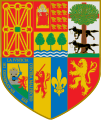Файл:Zazpiak Bat.svg
Перейти до навігації
Перейти до пошуку

Розмір цього попереднього перегляду PNG для вихідного SVG-файлу: 504 × 600 пікселів. Інші роздільності: 202 × 240 пікселів | 403 × 480 пікселів | 645 × 768 пікселів | 860 × 1024 пікселів | 1721 × 2048 пікселів | 579 × 689 пікселів.
Повна роздільність (SVG-файл, номінально 579 × 689 пікселів, розмір файлу: 1,38 МБ)
Історія файлу
Клацніть на дату/час, щоб переглянути, як тоді виглядав файл.
| Дата/час | Мініатюра | Розмір об'єкта | Користувач | Коментар | |
|---|---|---|---|---|---|
| поточний | 20:42, 30 квітня 2009 |  | 579 × 689 (1,38 МБ) | SanchoPanzaXXI~commonswiki | retoque lobos |
| 18:31, 30 квітня 2009 |  | 579 × 689 (1,39 МБ) | SanchoPanzaXXI~commonswiki | rediseño | |
| 19:52, 28 листопада 2007 |  | 550 × 650 (384 КБ) | SanchoPanzaXXI~commonswiki | {{Information |Description={{en}}Modern version of en:Zazpiak Bat insignia. From the Basque words zazpiak meaning "the seven ones" and bat meaning "one", translates as "the seven ones [are] one", refers to the seven historical Basque Country territor |
Використання файлу
Такі сторінки використовують цей файл:
Глобальне використання файлу
Цей файл використовують такі інші вікі:
- Використання в ar.wikipedia.org
- Використання в bs.wikipedia.org
- Використання в ca.wikipedia.org
- Використання в da.wikipedia.org
- Використання в en.wikipedia.org
- Використання в en.wikiversity.org
- Використання в eo.wikipedia.org
- Використання в es.wikipedia.org
- Euskal Herria
- Escudo de Navarra
- Usuario:Keat
- Usuario:Ultrasiete
- Usuario Discusión:Martiko
- Wikiproyecto:Euskal Herria
- Wikiproyecto Discusión:Euskal Herria
- Wikiproyecto:Euskal Herria/Userbox2
- Usuario:Tximist
- Usuario:Ignaciojd3
- Usuario:Zarateman
- Usuario:Janfri
- Zazpiak Bat
- Usuario:Rikku~eswiki
- Usuario Discusión:Tximist
- Wikiproyecto Discusión:Euskal Herria/Discusiones2
- Portal:Navarra/Portales Relacionados
- Portal:País Vasco
- Portal:País Vasco/Portales relacionados
- Inmigración vasca en Chile
- Usuario:Marine13
- Usuario:El-Numero
- Xabi Aburruzaga
- Usuario:Pablitop
- Usuario:Aberzale
- Usuario:Igalix/Archivo de 2007-2010
- Usuario:Userbox/Localización/España
- Usuaria:Userbox mujer/Localización/España
- Koruko Ama Birjinaren Eskola
- Usuario:Raulsalvatierra1998
- Usuario:Sejuzu
- Jean de Jaurgain
- Armorial de las familias vascas
- Usuario:Gogoter
- Використання в eu.wikipedia.org
Переглянути сторінку глобального використання цього файлу.
